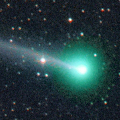
|
Now it is 6.9 mag (Feb. 6, Seiichi Yoshida). It will approach to the earth down to 0.08 a.u. to the earth in mid February, and it will be observable at 6 mag in good condition. In the Northern Hemisphere, it will be getting higher very rapidly in the morning sky. It will appear in the morning sky soon also in the Southern Hemisphere.
Date(TT) R.A. (2000) Decl. Delta r Elong. m1 Best Time(A, h)
Feb. 4 19 40.60 1 12.1 0.128 0.875 28 6.7 3:47 (278,-13)
Feb. 11 16 52.46 24 15.8 0.083 0.975 79 6.4 3:57 (230, 12)
|
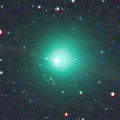
|
Already bright as 10.7 mag (Jan. 31, Thomas Lehmann). It will pass the perihelion on Mar. 10. In the Northern Hemisphere, it stays observable in the evening sky until late February while the comet will be brightening up to 8.5 mag. In the Southern Hemisphere, it will appear in the morning sky in late March at 8 mag, then it stays observable while the comet will be fading.
Date(TT) R.A. (2000) Decl. Delta r Elong. m1 Best Time(A, h)
Feb. 4 23 41.44 6 41.8 1.234 0.861 43 10.3 20:39 ( 96, -3)
Feb. 11 23 52.01 7 19.8 1.146 0.736 39 9.7 20:30 ( 96, -5)
|

|
Now it is 10.4 mag (Jan. 30, Thomas Lehmann). It is expected to brighten up to 7 mag in summer. In the Northern Hemisphere, it stays observable in good condition until the highlight while the comet will be brightening. In the Southern Hemisphere, it stays extremely low for a while.
Date(TT) R.A. (2000) Decl. Delta r Elong. m1 Best Time(A, h)
Feb. 4 15 40.19 44 44.0 2.013 2.335 96 9.9 3:47 (210, 1)
Feb. 11 15 51.94 45 3.7 1.924 2.275 97 9.7 3:57 (206, 3)
|
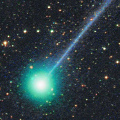
|
It brightened rapidly up to 6.8 mag (Jan. 6, Katsumi Yoshimoto). It approached to the sun down to 0.3 a.u. on Jan. 14. Michael Mattiazzo reported that the comet was visible in the SWAN images from Jan. 19 to Jan. 29 while it faded from 5 mag to 7 mag. Now it is not observable. It is not observable after this in the Northern Hemisphere. In the Southern Hemisphere, it will appear in the extremely low sky in the evening in late February.
Date(TT) R.A. (2000) Decl. Delta r Elong. m1 Best Time(A, h)
Feb. 4 21 27.87 -33 36.1 1.531 0.664 17 10.1 20:39 ( 45, -2)
Feb. 11 22 13.39 -33 17.6 1.657 0.814 20 11.2 20:30 ( 49, 1)
|
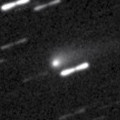
|
Now it is 11.2 mag (Feb. 1, Chris Wyatt). It is expected to brighten up to 7 mag in spring. But it locates somewhat low at the high light.
Date(TT) R.A. (2000) Decl. Delta r Elong. m1 Best Time(A, h)
Feb. 4 16 35.76 -23 23.9 2.020 1.825 64 10.6 3:47 (273, 39)
Feb. 11 16 58.37 -23 45.8 1.888 1.743 66 10.3 3:57 (272, 42)
|

|
Now it is 13.4 mag (Jan. 28, Piotr Guzik). It will brighten up to 12 mag from winter to spring. In the Northern Hemisphere, it will be unobservable soon. In the Southern Hemisphere, it stays observable for a long time after this.
Date(TT) R.A. (2000) Decl. Delta r Elong. m1 Best Time(A, h)
Feb. 4 17 33.20 -18 55.9 1.438 1.131 51 12.3 3:47 (276, 25)
Feb. 11 18 8.55 -20 7.2 1.406 1.085 50 12.2 3:57 (277, 26)
|
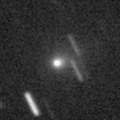
|
Now it is 12.8 mag (Jan. 29, Jakub Cerny). It will approach to the earth down to 0.14 a.u. from March to April. It is expected to brighten up to 5-6 mag. It may brighten furthermore in outburst. It is observable in excellent condition in the Northern Hemisphere. In the Southern Hemisphere, it will not be observable for about one month around the highlight. But it stays observable in good condition except for that period.
Date(TT) R.A. (2000) Decl. Delta r Elong. m1 Best Time(A, h)
Feb. 4 9 32.18 12 5.7 0.388 1.372 173 13.9 0:37 (180, 43)
Feb. 11 9 33.68 15 2.2 0.331 1.318 178 12.7 0:10 (180, 40)
|

|
Now it is not observable. It will appear in the morning sky in March.
Date(TT) R.A. (2000) Decl. Delta r Elong. m1 Best Time(A, h)
Feb. 4 20 38.37 -19 28.4 6.842 5.868 8 13.9 3:47 (303,-10)
Feb. 11 20 44.13 -19 2.6 6.819 5.866 13 13.9 3:57 (298, -5)
|

|
Now it is 13.7 mag (Jan. 24, Juan Jose Gonzalez). It is observable in excellent condition in the Northern Hemisphere. It stays low in the Southern Hemisphere.
Date(TT) R.A. (2000) Decl. Delta r Elong. m1 Best Time(A, h)
Feb. 4 12 6.74 29 19.6 1.646 2.465 137 14.1 3:11 (180, 26)
Feb. 11 12 5.85 30 11.2 1.620 2.477 142 14.1 2:42 (180, 25)
|

|
It has not been observed yet in this apparition. The condition of this apparition is worst. It will brighten up to 10 mag in spring, but not observable at all.
Date(TT) R.A. (2000) Decl. Delta r Elong. m1 Best Time(A, h)
Feb. 4 21 37.97 -6 3.3 2.410 1.461 12 14.9 20:39 ( 67,-20)
Feb. 11 21 59.08 -4 36.2 2.361 1.404 10 14.5 20:30 ( 69,-21)
|

|
Now it is bright as 14.4 mag (Jan. 14, Thomas Lehmann). It will be observable at 11 mag for a long time from 2017 to 2018. Now it is observable in excellent condition in the Southern Hemisphere. But it stays low for a while in the Northern Hemisphere.
Date(TT) R.A. (2000) Decl. Delta r Elong. m1 Best Time(A, h)
Feb. 4 2 47.29 -30 26.1 5.326 5.193 76 14.8 20:39 ( 85, 54)
Feb. 11 2 48.64 -29 1.6 5.350 5.141 72 14.8 20:30 ( 85, 50)
|

|
Now it is 14.3 mag (Dec. 31, Jakub Cerny). It will be fading slowly after this.
Date(TT) R.A. (2000) Decl. Delta r Elong. m1 Best Time(A, h)
Feb. 4 1 3.31 -2 50.4 5.657 5.214 58 14.9 20:39 (100, 19)
Feb. 11 1 8.45 -2 22.0 5.764 5.232 53 15.0 20:30 ( 99, 16)
|

|
Now it is 14.8 mag (Dec. 31, Yuji Ohshima). It stays 15 mag until spring. But it is already unobservable in the Southern Hemisphere. It will be getting lower gradually after this also in the Northern Hemisphere.
Date(TT) R.A. (2000) Decl. Delta r Elong. m1 Best Time(A, h)
Feb. 4 0 25.89 12 26.4 2.061 1.720 56 15.1 20:39 (107, 3)
Feb. 11 0 42.98 14 21.8 2.096 1.711 53 15.1 20:30 (109, 1)
|
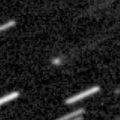
|
Now it is 16.9 mag (Jan. 26, Alexander Baransky). It will brighten up to 10 mag in summer, and it will be observable in excellent condition in the Southern Hemisphere. It locates low in the Northern Hemisphere.
Date(TT) R.A. (2000) Decl. Delta r Elong. m1 Best Time(A, h)
Feb. 4 14 57.26 -9 2.5 1.809 2.069 90 15.5 3:47 (238, 50)
Feb. 11 15 8.83 -9 53.7 1.699 2.032 94 15.2 3:57 (231, 55)
|

|
Now it is 15.7 mag (Jan. 4, T. Ikemura, H. Sato). It will brighten up to 14 mag from spring to summer. It locates somewhat low in the Northern Hemisphere. The perihelion distance increased from 2.4 a.u. to 2.9 a.u. in this apparition. So it will not be bright as before.
Date(TT) R.A. (2000) Decl. Delta r Elong. m1 Best Time(A, h)
Feb. 4 15 53.84 -17 12.3 3.271 3.165 75 15.4 3:47 (260, 44)
Feb. 11 16 0.99 -17 40.1 3.162 3.153 80 15.3 3:57 (255, 50)
|

|
Now it is 15.8 mag (Jan. 1, Ken-ichi Kadota). It will brighten up to 12-13 mag and will be observable in good condition in summer. It ia already unobservable in the Southern Hemisphere. It will be unobservable soon also in the Northern Hemisphere. It will appear in the morning sky in May.
Date(TT) R.A. (2000) Decl. Delta r Elong. m1 Best Time(A, h)
Feb. 4 0 7.84 13 59.9 3.933 3.436 53 15.4 20:39 (106, -2)
Feb. 11 0 7.77 13 41.5 4.001 3.395 46 15.4 20:30 (103, -6)
|

|
It brightened up to 11 mag from spring to summer in 2016. It is appearing in the morning sky again. It will be observable at 16-17 mag in good condition from spring to summer.
Date(TT) R.A. (2000) Decl. Delta r Elong. m1 Best Time(A, h)
Feb. 4 18 42.89 -21 10.5 3.154 2.416 35 15.5 3:47 (288, 12)
Feb. 11 18 55.54 -20 56.1 3.141 2.458 39 15.6 3:57 (284, 17)
|
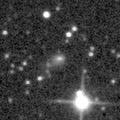
|
Now it is 16.7 mag (Nov. 3, Kunihiro Shima). It will be observable at 13 mag for a long time from 2017 to 2018. It is appearing in the morning sky again in the Northern Hemisphere.
Date(TT) R.A. (2000) Decl. Delta r Elong. m1 Best Time(A, h)
Feb. 4 19 3.12 -2 41.1 5.759 4.974 34 15.6 3:47 (275, -3)
Feb. 11 19 5.47 -1 53.9 5.655 4.936 39 15.5 3:57 (269, 4)
|
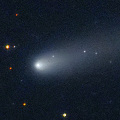
|
It brightened up to 11-12 mag from summer to autumn. Now it is fading. But it is bright as 13.6 mag still now (Jan. 24, Seiichi Yoshida).
Date(TT) R.A. (2000) Decl. Delta r Elong. m1 Best Time(A, h)
Feb. 4 12 30.57 -26 57.6 1.600 2.206 114 15.5 3:35 (180, 82)
Feb. 11 12 28.23 -27 26.2 1.576 2.254 121 15.7 3:05 (180, 83)
|
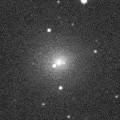
|
It brightened up to 11-12 mag in autumn. Now it is fading. But it is bright as 13.9 mag still now (Jan. 24, Seiichi Yoshida).
Date(TT) R.A. (2000) Decl. Delta r Elong. m1 Best Time(A, h)
Feb. 4 13 52.29 -16 18.1 1.743 2.190 103 15.7 3:47 (224, 66)
Feb. 11 13 54.79 -16 37.6 1.706 2.240 109 15.9 3:57 (205, 70)
|

|
Now it is 15.6 mag (Jan. 9, J. L. Martin). It stays observable at 16 mag in good condition until spring. It locates low in the Southern Hemisphere.
Date(TT) R.A. (2000) Decl. Delta r Elong. m1 Best Time(A, h)
Feb. 4 6 49.40 27 36.8 2.885 3.740 145 15.8 21:50 (180, 27)
Feb. 11 6 46.38 27 41.6 2.942 3.733 137 15.8 21:20 (180, 27)
|

|
Now it is 15.6 mag (Jan. 26, Alexander Baransky). It stays 16-17 mag for a long time from 2016 to 2019. It stays near by the equator.
Date(TT) R.A. (2000) Decl. Delta r Elong. m1 Best Time(A, h)
Feb. 4 9 14.34 2 47.0 8.673 9.634 166 15.9 0:19 (180, 52)
Feb. 11 9 12.69 3 4.6 8.664 9.629 167 15.9 23:46 (180, 52)
|

|
It was observed at 16 mag from spring to summer in 2016. It will be observable at 16 mag also in 2017 from winter to spring.
Date(TT) R.A. (2000) Decl. Delta r Elong. m1 Best Time(A, h)
Feb. 4 17 28.73 -7 47.2 3.728 3.259 54 16.1 3:47 (266, 20)
Feb. 11 17 37.30 -6 26.9 3.658 3.272 59 16.1 3:57 (260, 25)
|

|
It stayed bright 12 mag for a long time from autum in 2015 to summer in 2016. Now it is fading. It has already faded dwon to 15.6 mag (Jan. 6, Hiroshi Abe).
Date(TT) R.A. (2000) Decl. Delta r Elong. m1 Best Time(A, h)
Feb. 4 17 17.56 -5 18.0 4.688 4.249 58 16.2 3:47 (262, 21)
Feb. 11 17 20.30 -5 44.4 4.641 4.299 63 16.2 3:57 (257, 28)
|

|
It brightened up to 6 mag from autumn in 2015 to early 2016. Now it is fading. It has already faded down to 16.0 mag (Jan. 1, Yuji Ohshima). It is observable in good condition in the Northern Hemisphere. It is not observable after this in the Southern Hemisphere.
Date(TT) R.A. (2000) Decl. Delta r Elong. m1 Best Time(A, h)
Feb. 4 2 54.46 47 9.2 5.475 5.717 99 16.3 20:39 (154, 0)
Feb. 11 2 54.13 46 23.6 5.651 5.783 92 16.4 20:30 (151, -1)
|

|
It has not been observed since last April. Now it is fading. But it must be bright as 16 mag still now.
Date(TT) R.A. (2000) Decl. Delta r Elong. m1 Best Time(A, h)
Feb. 4 16 35.44 -20 54.4 2.843 2.583 64 16.4 3:47 (271, 38)
Feb. 11 16 43.73 -20 49.3 2.824 2.654 70 16.5 3:57 (266, 43)
|

|
Now it is 16.5 mag (Dec. 29, Sandor Szabo). It will brighten up to 15 mag and will be observable in good condition from autum to winter in 2017. In the Northern Hemisphere, it stays observable in good condition for a long time while the comet will be brightening. It is not observable until summer in the Southern Hemisphere.
Date(TT) R.A. (2000) Decl. Delta r Elong. m1 Best Time(A, h)
Feb. 4 1 52.90 41 36.6 4.950 4.997 87 16.5 20:39 (142, -2)
Feb. 11 1 52.67 40 21.5 5.041 4.968 80 16.5 20:30 (138, -4)
|

|
Now it is 16.4 mag (Jan. 3, T. Ikemura, H. Sato). It stays 16 mag for a long time from 2017 to 2018.
Date(TT) R.A. (2000) Decl. Delta r Elong. m1 Best Time(A, h)
Feb. 4 9 4.53 -5 52.3 4.827 5.752 157 16.5 0:09 (180, 61)
Feb. 11 8 58.08 -4 40.3 4.802 5.733 158 16.5 23:30 (180, 60)
|

|
Now it is 16.5 mag (Dec. 26, A. Diepvens). It stays 16.5 mag from 2016 to 2017. In the Northern Hemisphere, it stays observable in good condition for a long time. In the Southern Hemisphere, it will never be observable again.
Date(TT) R.A. (2000) Decl. Delta r Elong. m1 Best Time(A, h)
Feb. 4 18 20.41 39 45.1 6.548 6.256 68 16.6 3:47 (233,-18)
Feb. 11 18 26.29 40 54.6 6.516 6.259 70 16.6 3:57 (229,-13)
|

|
Now it is 16.8 mag (Jan. 6, D. Buczynski). It is expected to brighten up to 9 mag in summer in 2018. In the Northern Hemisphere, it stays observable until 2018 summer while the comet will be brightening. In the Southern Hemisphere, it is hardly observable in 2017, but it will be observable in good condition in 2018.
Date(TT) R.A. (2000) Decl. Delta r Elong. m1 Best Time(A, h)
Feb. 4 18 44.84 45 2.1 6.238 5.968 69 16.7 3:47 (231,-24)
Feb. 11 18 49.92 45 14.8 6.168 5.912 70 16.7 3:57 (228,-19)
|
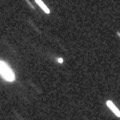
|
Now it is 17.1 mag (Jan. 9, ATLAS-HKO, Haleakala). It brightened rapidly, and became brighter than originally expected. It stays 17 mag until 2017. In the Northern Hemisphere, it stays observable in excellent condition for a long time. It is not observable in the Southern Hemisphere.
Date(TT) R.A. (2000) Decl. Delta r Elong. m1 Best Time(A, h)
Feb. 4 13 29.79 59 17.4 6.869 7.365 116 16.9 3:47 (186, -5)
Feb. 11 13 23.35 59 53.7 6.847 7.372 118 16.9 3:57 (180, -5)
|

|
It brightened up to 15 mag in early 2016. Now it is fading. It has already faded down to 16.3 mag (Dec. 30, Sandor Szabo). In the Northern Hemisphere, it stays observable in good condition for a long time until 2017 autumn when the comet will be fainter than 18 mag. It will never be observable after this in the Southern Hemisphere.
Date(TT) R.A. (2000) Decl. Delta r Elong. m1 Best Time(A, h)
Feb. 4 15 35.32 68 38.6 6.021 6.315 102 16.9 3:47 (195,-18)
Feb. 11 15 36.58 69 12.8 6.043 6.343 103 16.9 3:57 (192,-17)
|

|
Now it is 16.1 mag (Dec. 30, Yuji Ohshima). It is observable in excellent condition in the Northern Hemisphere. It locates low in the Southern Hemisphere. It will be fainter than 18 mag in March.
Date(TT) R.A. (2000) Decl. Delta r Elong. m1 Best Time(A, h)
Feb. 4 6 43.92 34 26.7 2.617 3.452 142 17.0 21:45 (180, 21)
Feb. 11 6 42.25 34 8.5 2.687 3.461 135 17.1 21:16 (180, 21)
|
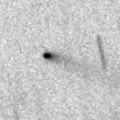
|
Now it is 17.2 mag (Jan. 8, D. Buczynski). It was observed at 17 mag last winter. It will be observable at 17 mag again next winter. It is observable in good condition in the Northern Hemisphere. But it locates low in the Southern Hemisphere.
Date(TT) R.A. (2000) Decl. Delta r Elong. m1 Best Time(A, h)
Feb. 4 11 25.08 31 16.7 3.195 4.049 145 17.1 2:29 (180, 24)
Feb. 11 11 22.78 33 6.3 3.193 4.075 149 17.1 1:59 (180, 22)
|

|
It has not been observed yet in this apparition. It will brighten up to 12 mag in summer. It will be observable in excellent condition in the Southern Hemisphere. It locates somewhat low in the Northern Hemisphere.
Date(TT) R.A. (2000) Decl. Delta r Elong. m1 Best Time(A, h)
Feb. 4 16 57.27 -31 27.3 2.970 2.604 59 17.3 3:47 (285, 38)
Feb. 11 17 10.35 -31 52.4 2.864 2.575 63 17.1 3:57 (283, 43)
|
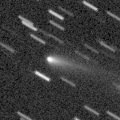
|
It brightened up to 14.6 mag from autum to winter (Dec. 2, Kunihiro Shima). Now it is fading. It has already faded down to 16.3 mag (Jan. 5, E. Bryssinck). It will be fainter than 18 mag in March.
Date(TT) R.A. (2000) Decl. Delta r Elong. m1 Best Time(A, h)
Feb. 4 4 11.85 31 1.2 2.421 2.926 111 17.1 20:39 (160, 21)
Feb. 11 4 16.83 30 48.5 2.534 2.952 105 17.3 20:30 (157, 20)
|

|
It will pass the perihelion in 2019. However, it has not been brightening since the discovery in 2010. Now it is 17.1 mag (Jan. 4, T. Ikemura, H. Sato). It stays observable in excellent condition in the Northern Hemisphere. It is not observable in the Southern Hemisphere.
Date(TT) R.A. (2000) Decl. Delta r Elong. m1 Best Time(A, h)
Feb. 4 3 42.00 60 57.9 9.175 9.526 108 17.2 20:39 (166, -9)
Feb. 11 3 42.00 60 44.6 9.242 9.508 102 17.2 20:30 (164,-10)
|

|
Now it is 18.2 mag (Dec. 6, T. Ikemura, H. Sato). It was expected to be observable at 17 mag in good condition in winter. But actually, it is fainter than this ephemeris.
Date(TT) R.A. (2000) Decl. Delta r Elong. m1 Best Time(A, h)
Feb. 4 12 50.80 -0 46.8 1.958 2.629 123 17.2 3:47 (183, 56)
Feb. 11 12 50.60 -0 14.9 1.912 2.659 130 17.3 3:27 (180, 55)
|
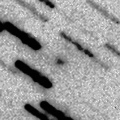
|
Now it is 17.2 mag (Dec. 30, A. Diepvens). In the Northern Hemisphere, it is observable at 17-18 mag until March. It is not observable in the Southern Hemisphere.
Date(TT) R.A. (2000) Decl. Delta r Elong. m1 Best Time(A, h)
Feb. 4 18 33.41 60 31.0 1.819 1.960 83 17.2 3:47 (214,-29)
Feb. 11 18 30.12 64 38.3 1.782 1.982 86 17.2 3:57 (208,-26)
|

|
Now it is 19.4 mag (Jan. 25, D. Abreu, et al.). Small comet, but it approaches to the sun down to 0.9 a.u., and to the earth down to 0.5 a.u., and it will brighten up to 16-17 mag from February to April. It is observable in excellent condition in the Northern Hemisphere. In the Southern Hemisphere, it stays observable only until mid February.
Date(TT) R.A. (2000) Decl. Delta r Elong. m1 Best Time(A, h)
Feb. 4 1 52.81 6 23.1 0.777 1.067 73 17.7 20:39 (117, 23)
Feb. 11 1 59.84 12 10.8 0.737 1.009 69 17.4 20:30 (119, 17)
|

|
It brightened up to 8-9 mag from winter to spring in 2016. Now it is fading. It has already faded down to 17.1 mag (Dec. 6, T. Ikemura, H. Sato).
Date(TT) R.A. (2000) Decl. Delta r Elong. m1 Best Time(A, h)
Feb. 4 13 9.70 -14 29.3 4.438 4.913 113 17.4 3:47 (198, 69)
Feb. 11 13 6.39 -14 57.4 4.391 4.971 120 17.5 3:43 (180, 70)
|
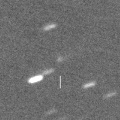
|
Now it is 17.4 mag (Jan. 25, Alexander Baransky). It is observable at 17.5 mag in good condition from winter to spring.
Date(TT) R.A. (2000) Decl. Delta r Elong. m1 Best Time(A, h)
Feb. 4 14 46.03 -10 6.9 2.064 2.332 92 17.4 3:47 (236, 53)
Feb. 11 14 53.17 -10 35.3 1.994 2.347 98 17.5 3:57 (227, 58)
|
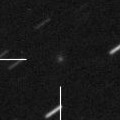
|
Now it is 17.3 mag (Jan. 8, CAO, San Pedro de Atacama). It is observable at 17.5 mag in good condition in this winter in the Southern Hemisphere.
Date(TT) R.A. (2000) Decl. Delta r Elong. m1 Best Time(A, h)
Feb. 4 6 6.10 -42 3.7 3.442 3.860 107 17.5 21:06 ( 0, 83)
Feb. 11 5 59.06 -39 19.3 3.468 3.861 106 17.6 20:32 ( 0, 86)
|

|
It brightened up to 6.2 mag in June in 2016 (June 24, Marco Goiato). Now it is fading. It has already faded down to 17.1 mag (Jan. 6, B. Lutkenhoner, W. F. Cashwell). In the Southern Hemisphee, it stays observable in excellent condition after this. It stays low in the Northern Hemisphere.
Date(TT) R.A. (2000) Decl. Delta r Elong. m1 Best Time(A, h)
Feb. 4 14 58.88 -34 27.8 3.911 3.918 83 17.8 3:47 (279, 62)
Feb. 11 14 54.13 -34 45.3 3.850 3.988 90 17.9 3:57 (276, 71)
|
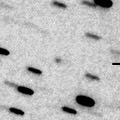
|
Now it is 18.9 mag (Dec. 27, K. Hills). It is observable at 18 mag in good condition from January to March.
Date(TT) R.A. (2000) Decl. Delta r Elong. m1 Best Time(A, h)
Feb. 4 10 45.63 -8 0.3 2.306 3.173 146 17.8 1:50 (180, 63)
Feb. 11 10 41.64 -8 17.8 2.283 3.192 152 17.8 1:18 (180, 63)
|
|
![]()
 C/2016 R2 ( PanSTARRS )
C/2016 R2 ( PanSTARRS ) C/2011 KP36 ( Spacewatch )
C/2011 KP36 ( Spacewatch ) 93P/Lovas 1
93P/Lovas 1 71P/Clark
71P/Clark 65P/Gunn
65P/Gunn C/2015 VL62 ( Lemmon-Yeung-PanSTARRS )
C/2015 VL62 ( Lemmon-Yeung-PanSTARRS ) 81P/Wild 2
81P/Wild 2 C/2015 O1 ( PanSTARRS )
C/2015 O1 ( PanSTARRS ) 43P/Wolf-Harrington
43P/Wolf-Harrington 144P/Kushida
144P/Kushida 74P/Smirnova-Chernykh
74P/Smirnova-Chernykh C/2014 B1 ( Schwartz )
C/2014 B1 ( Schwartz ) C/2016 B1 ( NEOWISE )
C/2016 B1 ( NEOWISE ) C/2014 W2 ( PanSTARRS )
C/2014 W2 ( PanSTARRS ) C/2013 US10 ( Catalina )
C/2013 US10 ( Catalina ) C/2015 TQ209 ( LINEAR )
C/2015 TQ209 ( LINEAR ) C/2015 V1 ( PanSTARRS )
C/2015 V1 ( PanSTARRS ) C/2016 A1 ( PanSTARRS )
C/2016 A1 ( PanSTARRS ) C/2014 OE4 ( PanSTARRS )
C/2014 OE4 ( PanSTARRS ) C/2016 M1 ( PanSTARRS )
C/2016 M1 ( PanSTARRS ) C/2014 R3 ( PanSTARRS )
C/2014 R3 ( PanSTARRS ) C/2013 V4 ( Catalina )
C/2013 V4 ( Catalina ) P/2015 TP200 ( LINEAR )
P/2015 TP200 ( LINEAR ) C/2015 X7 ( ATLAS )
C/2015 X7 ( ATLAS ) 213P/Van Ness
213P/Van Ness 56P/Slaughter-Burnham
56P/Slaughter-Burnham C/2010 U3 ( Boattini )
C/2010 U3 ( Boattini ) 118P/Shoemaker-Levy 4
118P/Shoemaker-Levy 4 C/2016 T2 ( Matheny )
C/2016 T2 ( Matheny ) C/2016 VZ18 ( PanSTARRS )
C/2016 VZ18 ( PanSTARRS ) C/2014 S2 ( PanSTARRS )
C/2014 S2 ( PanSTARRS ) 94P/Russell 4
94P/Russell 4 C/2017 A3 ( Elenin )
C/2017 A3 ( Elenin ) C/2013 X1 ( PanSTARRS )
C/2013 X1 ( PanSTARRS ) 330P/2015 U1 ( Catalina )
330P/2015 U1 ( Catalina )![]()









































